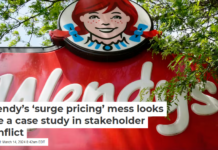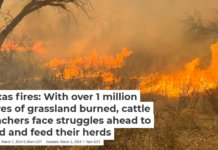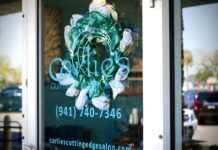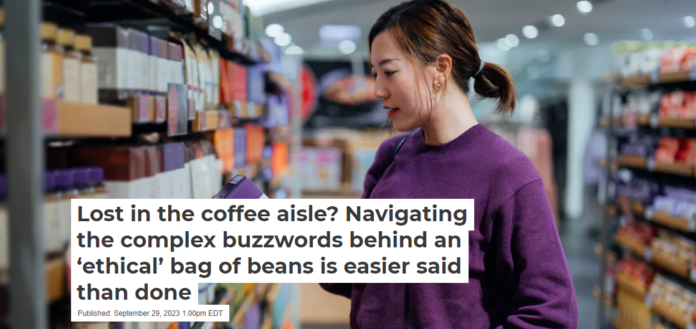

You’re shopping for a bag of coffee beans at the grocery store. After reading about the effects of climate change and how little farmers make – typically $0.40 per cup – you figure it might be time to change your usual beans and buy something more ethical. Perusing the shelves in the coffee aisle, though, you see too many choices.
First up is the red tub of Folgers “100% Colombian,” a kitchen staple – “lively with a roasted and rich finish.” On the side of the tub, you see the icon of Juan Valdez with his donkey, Conchita – a fictional mascot representing the Colombian Coffee Growers Federation.
Next might be Starbucks “Single-Origin Colombia.” One side of the green bag tells “the story” of the beans, describing “treacherous dirt roads” to “6,500 feet of elevation” that are “worth the journey every time.” The other shows a QR code and promises Starbucks is “Committed to 100% Ethical Coffee Sourcing in partnership with Conservation International.”
Then again, you’ve heard that a “better” choice would be to buy from local cafes. The bag from your local roaster introduces you to La Familia Vieira of Huila, Colombia, who have worked as coffee farmers for four generations at 1,600 meters above sea level – about a mile. But then there’s a flood of unfamiliar lingo: the 88-point anerobic-processed coffee was sourced directly from an importer who has a six-year relationship with the family, paid $3.70 per pound at farmgate, and $6.10 per pound FOB at a time when the C-market price was $1.60 per pound.
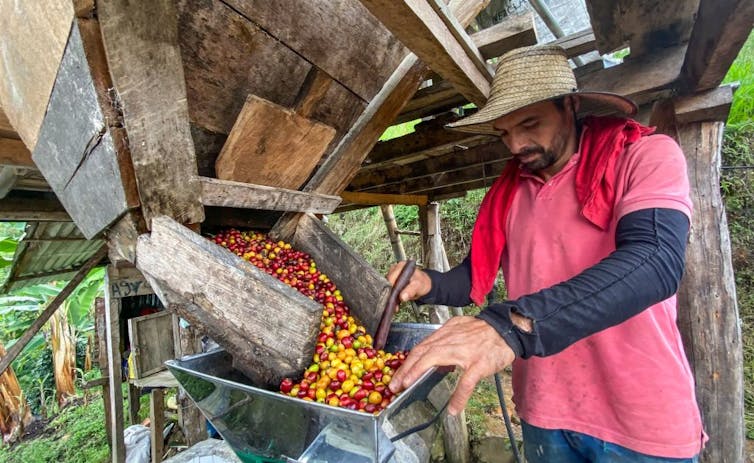
If you’re about ready to toss in the towel, you’re hardly alone. Consumers are often asked to make more responsible choices. Yet when it comes to commodity goods like coffee, the complex production chain can turn an uncomplicated habit into a complicated decision.
As a coffee enthusiast and marketing professor who researches marketplace justice, I’ve long been fascinated with how ethics and coffee consumption are intertwined. Before COVID-19, my family adopted a cat and named him Yukro, after a coffee-producing community in Ethiopia. While we were quarantining at home, I ordered Yukro-originating coffee from as many roasters as I could find to try to understand how consumers were supposed to make an informed choice.
Paradoxically, the more information I gleaned, the less I knew how to make a responsible decision. Indeed, prior research has indicated that information overload increases the paradox of choice; this is no different when factoring in ethical information. Additionally, as with a lot of consumer-facing information, it can be difficult to tell what information is relevant or credible.
Marketers attempt to simplify this overload by using buzzwords that sound good but may not get across much nuance. However, you might consider some of these terms when trying to decide between “100% Colombian” and the Vieira family.
Fair trade
As a benchmark, the coffee industry typically uses the “C-price”: the traded price on the New York Intercontinental Exchange for a pound of coffee ready for export. “Fair trade” implies the coffee is fairly traded, often with the goal of paying farmers minimum prices – and fixed premiums – above the C-price.
There are a few different fair trade certifications, such as Fairtrade America or Fair Trade Certified. Each of these has its own, voluntary certification standards linked with the associated organization. Yet obtaining certification can come at significant additional cost for farms or importers.
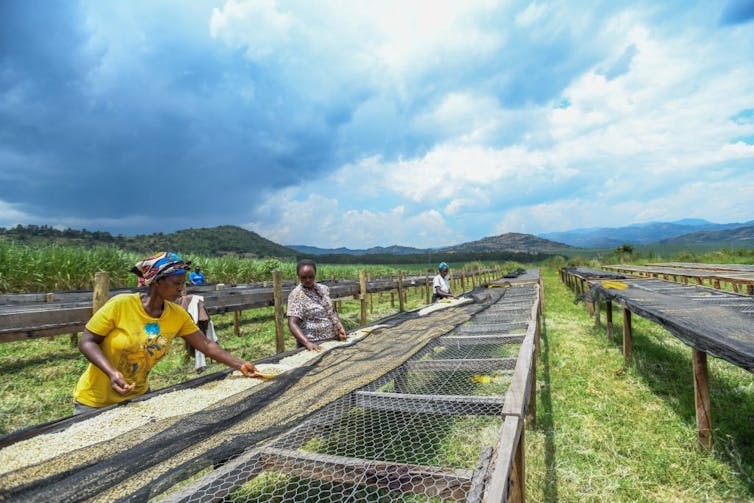
In contrast, some importers, or even roasters, have established relationships with specific farms, rather than buying beans at auction on the open market. These relationships potentially allow the importers to work directly with farmers over multi-year periods to improve the coffee quality and conditions. Longer-term commitment can provide farmers more certainty in times when the C-price is below their cost of production.
Yet these arrangements can be just as volatile for farmers if the importers they’ve committed to cannot find roasters interested in buying their beans – beans they could have sold at auction themselves.
100% arabica
There are several species of coffee, but approximately 70% of the world’s production comes from the arabica species, which grows well at higher altitudes. Like with wine, there are several varieties of arabica, and they tend to be a bit sweeter than other species – making arabica the ideal species for satisfying consumers.
In other words, a label like “100% arabica” is meant to signal deliciousness and prestige – though it’s about as descriptive as calling a bottle of pinot noir “100% red.”
When it comes to the environment, though, arabica isn’t necessarily a win. Many arabica varieties are susceptible to climate change-related conditions such as coffee rust – a common fungus that spreads easily and can devastate farms – or drought.
Other coffee species such as robusta or the less common eugenioides are more climate-change resistant, reducing costs of production for farmers, and are cheaper on commodity markets. However, they have a bit of a different taste profile than what folks are normally used to, which could mean lower earnings for farmers who make the switch, but could also provide new opportunities in areas where coffee was not previously farmed or to new markets of consumers’ tastes.
Single-origin
If someone labeled a peach as “American,” a consumer would rightly wonder where exactly it came from. Similarly, “single-origin” is a very broad description that could mean the coffee came from “Africa” or “Ethiopia” or “Jimma Zone” – even the zone’s specific town of “Agaro.” “Single-estate” at least gives slightly more farm-level information, though even this information may be tough to come by.
Consumers have tended to want their coffee’s journey from seed to cup to be traceable and transparent, which implies that everyone along the production chain is committed to equity – and “single-origin” appears to provide those qualities.
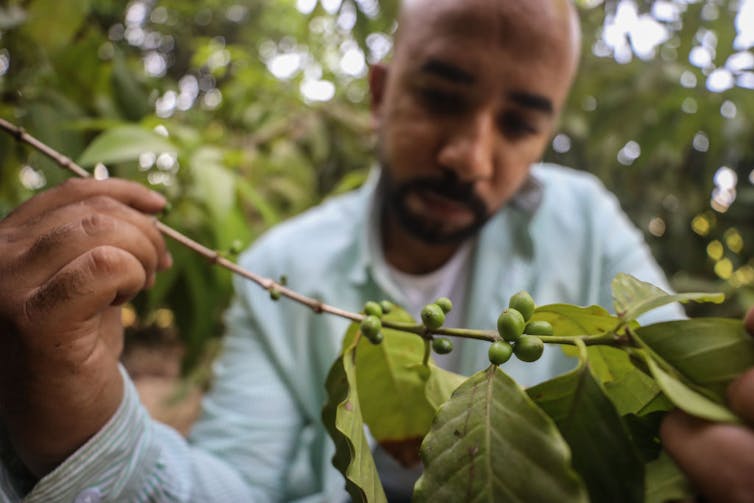
As a result, some coffee marketers invest quite a bit in being able to craft a narrative that emotionally resonates with consumers and makes them feel “connected” to the farm. Others have developed blockchain solutions where each step along the coffee’s journey, from bean to retail, is documented in a database that consumers can look at. Since blockchain data are immutable, the information a consumer gets from scanning a QR code on a label of a coffee bag should provide a clear chain of provenance.
Shade-grown
Shade-grown labels indicate that farms have adopted a more environmentally sustainable method, using biomatter like dead leaves as natural fertilizer for the coffee shrubs growing beneath a canopy of trees. Unlike other methods, shade-grown coffee doesn’t increase deforestation, and it protects habitats for animals like migratory birds – which is why the Smithsonian’s National Zoo and Conservation Biology Institute, which has developed its own coffee certification program, calls it “bird-friendly.”
But as with fair trade, there are costs associated with certification, and those costs are often passed on to consumers. Farmers or importers are left justifying the cost and wondering if the specialized label can attract a large enough market to validate their decision to certify. That said, many farmers who have the ability will do shade-grown regardless, since it’s a better farming practice and saves some costs on fertilizer.
In the end, all this information – or lack thereof – is a tool for consumers to use when making their coffee choices. Like any tool, sometimes it’s helpful, and sometimes not. These labels might not make your decision any easier, and might drive you right back to your “usual” bag of beans – but at least your choice can be more nuanced.
Spencer M. Ross, Associate Professor of Marketing, UMass Lowell
This article is republished from The Conversation under a Creative Commons license. Read the original article.




